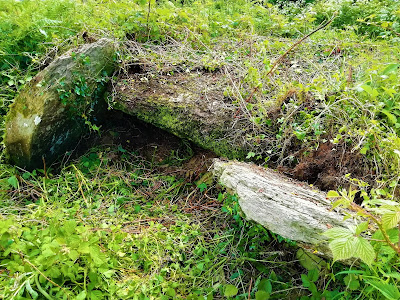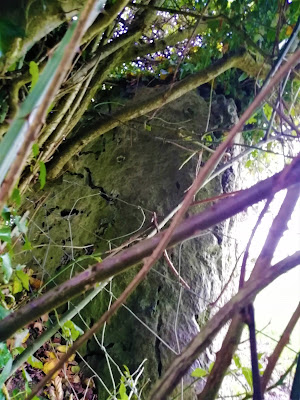Near the small Townland of Clopook in Laois is a Standing Stone, The Standing Stone of Clopook sometimes known as Tullamoy Standing Stone.
Legend has it that the Stone was thrown from the Rock of Dunamase by a Giant who was competing against a fellow Giant to see who could hurl a stone the farthest. The stone was dropped in mid throw by the Giant and landed in Clopook where it stands today.
There aren't many Megaliths or Megalithic structures in Laois that have been discovered above ground and classified though this doesn't mean that there is a lack of them, perhaps they are there and have yet to be discovered.
In an effort to subdue rebellious and unruly areas Laois along with Offaly was "settled" in the mid 16th century by "Plantation." This involved the dispossession of local Landholders, Chiefs, and figures of importance by "settlers" from England Scotland and Wales chiefly, who were granted lands, titles and estates.
Natives were able to avail of the disbursement of lands to those who were conquered, swore fealty, and subsequently submitted to English Crown rule... a programme which had been ongoing for Centuries.
Natives were able to avail of the disbursement of lands to those who were conquered, swore fealty, and subsequently submitted to English Crown rule... a programme which had been ongoing for Centuries.
This ongoing process from the time of the Tudor reign of Mary took a while however it led to huge estates being formed in Laois and subsequently large scale farming and agriculture developed. That subsequent farming and agriculture may itself be a reason why so few Megalithic sites remain or have been discovered in Laois which has extensive tract's of flat arable lands.
It's possible that many small Megalithic structures have been destroyed or have been "ploughed under" into the ground in the intervening time period without landowners being aware of what they were or represented.
I don't know and this is just a supposition however looking at the scale of agriculture and tillage in particular, this seems a likely probable cause for the lack of Megaliths in Laois.
I don't know and this is just a supposition however looking at the scale of agriculture and tillage in particular, this seems a likely probable cause for the lack of Megaliths in Laois.
The few I have seen are Ballycoolan Cairn, a likely Neolithic or Bronze Age Burial Tomb (Unclassified) which needs further archaeological investigation.
Manger Cist, a possible Bronze Age burial Cist
(again Unclassified).
The Giant's Grave at Cadamstown (technically Offaly), which was some type of large Megalithic burial structure toppled in the search for buried treasure.
The Standing Stone's of Clopook (Tullamoy), Newtown Skirk, Clonfertmulloe, and Timoney Hills
(just outside Laois).
Manger Cist, a possible Bronze Age burial Cist
(again Unclassified).
The Giant's Grave at Cadamstown (technically Offaly), which was some type of large Megalithic burial structure toppled in the search for buried treasure.
The Standing Stone's of Clopook (Tullamoy), Newtown Skirk, Clonfertmulloe, and Timoney Hills
(just outside Laois).
All are interesting and historic relics of the County's distant prehistoric past. Most are hard to locate and some will require the permission of local landowners should you wish to gain access.
I've posted a few photographs throughout this post of the various Megaliths and Orthostats mentioned and although none are on a grand scale they nevertheless belie an interpretation of the landscape of Laois from times past.
Most are located in scenic and beautiful areas well off the beaten track and each is worth a visit in its own right.
Most are located in scenic and beautiful areas well off the beaten track and each is worth a visit in its own right.
Traveling from place to place in the County you will doubtless pass numerous Raths, Hillforts, Mottes, Castles, Church Ruins and Abbeys.
Clonaslee in Laois had a rich neolithic past yet as far as I am aware all trace of neolithic structural activity at Clonaslee has long since been destroyed and any prehistoric Tombs or Dolmens have vanished.
A large number of Standing Stones of antiquity have been demolished throughout Laois, some with the use of explosives to clear them from the fields.
A Sheela na Gig from Rosenallis lies not in Rosenallis.... but in Dublin.
There is no doubt and very evidently a love and duty of care exercised by many landowners who have discovered or inherited antiquities on their property. More so in recent decades as the importance of these artifacts has been brought more and more into focus.
Laois has no recorded Ogham, no classified (above ground) Passage Tombs or Dolmens, few Crosses whether High, Pillar or Wayside etc. etc. etc.
It also has no County Museum (as of Dec/2019).
Scarce resources and capital from exchequer funding are diverted all too often to large scale projects primarily with a focus on tourism and as a means of generating income at very specific well know locations. As a result visitor numbers at these locations are approaching unsustainable levels....Maximum Saturation.
If more resources, effort and lobbying are not diverted to and carried out on behalf of areas with little by way of large scale Heritage sites and a long history of decades of lack of investment in heritage, history and archaeology, many of these smaller but nonetheless important antiquities and sites will be lost forever in Laois and throughout other neglected midland counties.
At some stage at a National level heritage will have to be addressed for its intrinsic value not merely for its contribution to GDP.
The volunteer ethos and effort has restored or preserved many sites throughout Laois but without doubt unless more attention and resources are placed on areas like Laois, Roscommon, Longford and Tipperary, and other long neglected counties it is inevitable that more and more historic sites and heritage will disappear from the Irish heritage landscape forever through neglect or abandonment.
Relics and Reliquaries. Iron age weapons, tools and utensils. Bronze age Jewellery and Christian era Illuminated Manuscripts and Inscribes Stones. Mesolithic hunter gatherer Axes and tools.
These are just some of the many important and beautiful artifacts discovered in Laois and the midlands. I have been fortunate to see a lot of them ........... in Dublin and Britain!
Newgrange, Killarney and Wicklow. Dublin and Galway among others........ Bustling and prospering places, however they don't represent the totality of Ireland's rich heritage.
Keep the wheels turning.











